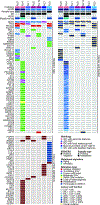Nonlobular Invasive Breast Carcinomas with Biallelic Pathogenic CDH1 Somatic Alterations: A Histologic, Immunophenotypic, and Genomic Characterization
- PMID: 37925055
- PMCID: PMC11154908
- DOI: 10.1016/j.modpat.2023.100375
Nonlobular Invasive Breast Carcinomas with Biallelic Pathogenic CDH1 Somatic Alterations: A Histologic, Immunophenotypic, and Genomic Characterization
Abstract
CDH1 encodes for E-cadherin, and its loss of function is the hallmark of invasive lobular carcinoma (ILC). Albeit vanishingly rare, biallelic CDH1 alterations may be found in nonlobular breast carcinomas (NL-BCs). We sought to determine the clinicopathologic characteristics and repertoire of genetic alterations of NL-BCs harboring CDH1 biallelic genetic alterations. Analysis of 5842 breast cancers (BCs) subjected to clinical tumor-normal sequencing with an FDA-cleared multigene panel was conducted to identify BCs with biallelic CDH1 pathogenic/likely pathogenic somatic mutations lacking lobular features. The genomic profiles of NL-BCs with CDH1 biallelic genetic alterations were compared with those of ILCs and invasive ductal carcinomas (IDCs), matched by clinicopathologic characteristics. Of the 896 CDH1-altered BCs, 889 samples were excluded based on the diagnosis of invasive mixed ductal/lobular carcinoma or ILC or the detection of monoallelic CDH1 alterations. Only 7 of the 5842 (0.11%) BCs harbored biallelic CDH1 alterations and lacked lobular features. Of these, 4/7 (57%) cases were ER-positive/HER2-negative, 1/7 (14%) was ER-positive/HER2-positive, and 2/7 (29%) were ER-negative/HER2-negative. In total, 5/7 (71%) were of Nottingham grade 2, and 2/7 (29%) were of grade 3. The NL-BCs with CDH1 biallelic genetic alterations included a mucinous carcinoma (n = 1), IDCs with focal nested growth (n = 2), IDC with solid papillary (n = 1) or apocrine (n = 2) features, and an IDC of no special type (NST; n = 1). E-cadherin expression, as detected by immunohistochemistry, was absent (3/5) or aberrant (discontinuous membranous/cytoplasmic/granular; 2/5). However, NL-BCs with CDH1 biallelic genetic alterations displayed recurrent genetic alterations, including TP53, PIK3CA (57%, 4/7; each), FGFR1, and NCOR1 (28%, 2/7, each) alterations. Compared with CDH1 wild-type IDC-NSTs, NL-BCs less frequently harbored GATA3 mutations (0% vs 47%, P = .03), but no significant differences were detected when compared with matched ILCs. Therefore, NL-BCs with CDH1 biallelic genetic alterations are vanishingly rare, predominantly comprise IDCs with special histologic features, and have genomic features akin to luminal B ER-positive BCs.
Keywords: CDH1; E-cadherin; breast cancer; ductal; lobular.
Copyright © 2023 United States & Canadian Academy of Pathology. Published by Elsevier Inc. All rights reserved.
Conflict of interest statement
CONFLICT OF INTEREST
J.S.R.-F. reports receiving personal/consultancy fees from Goldman Sachs, Bain Capital, REPARE Therapeutics, Saga Diagnostics and Paige.AI, membership of the scientific advisory boards of VolitionRx, REPARE Therapeutics and Paige.AI, membership of the Board of Directors of Grupo Oncoclinicas, and ad hoc membership of the scientific advisory boards of AstraZeneca, Merck, Daiichi Sankyo, Roche Tissue Diagnostics and Personalis, outside the scope of this study. B.W. reports research funding from Repare Therapeutics, outside the scope of the submitted work. F.P. reports membership of the scientific advisory board of MultiplexDx.
Figures



Similar articles
-
E-cadherin immunohistochemical expression in invasive lobular carcinoma of the breast: correlation with morphology and CDH1 somatic alterations.Hum Pathol. 2020 Aug;102:44-53. doi: 10.1016/j.humpath.2020.06.002. Epub 2020 Jun 26. Hum Pathol. 2020. PMID: 32599083 Free PMC article.
-
The genomic landscape of metastatic histologic special types of invasive breast cancer.NPJ Breast Cancer. 2020 Oct 14;6:53. doi: 10.1038/s41523-020-00195-4. eCollection 2020. NPJ Breast Cancer. 2020. PMID: 33083532 Free PMC article.
-
ERBB2 mutation is associated with a worse prognosis in patients with CDH1 altered invasive lobular cancer of the breast.Oncotarget. 2016 Dec 6;7(49):80655-80663. doi: 10.18632/oncotarget.13019. Oncotarget. 2016. PMID: 27811364 Free PMC article.
-
Comprehensive Review of Molecular Mechanisms and Clinical Features of Invasive Lobular Cancer.Oncologist. 2021 Jun;26(6):e943-e953. doi: 10.1002/onco.13734. Epub 2021 Mar 16. Oncologist. 2021. PMID: 33641217 Free PMC article. Review.
-
Problematic breast tumors reassessed in light of novel molecular data.Mod Pathol. 2021 Jan;34(Suppl 1):38-47. doi: 10.1038/s41379-020-00693-7. Epub 2020 Oct 6. Mod Pathol. 2021. PMID: 33024304 Free PMC article. Review.
Cited by
-
A Genomics-Driven Artificial Intelligence-Based Model Classifies Breast Invasive Lobular Carcinoma and Discovers CDH1 Inactivating Mechanisms.Cancer Res. 2024 Oct 15;84(20):3478-3489. doi: 10.1158/0008-5472.CAN-24-1322. Cancer Res. 2024. PMID: 39106449 Free PMC article.
-
Pitfalls in the Histological Diagnosis of Morphologic Variants of Invasive Lobular Carcinoma of the Breast.Mod Pathol. 2025 Jul 3;38(9):100837. doi: 10.1016/j.modpat.2025.100837. Online ahead of print. Mod Pathol. 2025. PMID: 40617531 Review.
-
E-cadherin staining in the diagnosis of lobular versus ductal neoplasms of the breast: the emperor has no clothes.Histopathology. 2025 Feb;86(3):327-340. doi: 10.1111/his.15295. Epub 2024 Aug 13. Histopathology. 2025. PMID: 39138705 Free PMC article. Review.
References
-
- Gatza ML, Carey LA. Another Breast Cancer Entity Confirmed: Genomics of Invasive Lobular Breast Cancer. J Clin Oncol. Jun 1 2016;34(16):1838–9. - PubMed
-
- Gall TM, Frampton AE. Gene of the month: E-cadherin (CDH1). J Clin Pathol. Nov 2013;66(11):928–32. - PubMed
-
- Droufakou S, Deshmane V, Roylance R, Hanby A, Tomlinson I, Hart IR. Multiple ways of silencing E-cadherin gene expression in lobular carcinoma of the breast. Int J Cancer. May 1 2001;92(3):404–8. - PubMed
MeSH terms
Substances
Grants and funding
LinkOut - more resources
Full Text Sources
Medical
Research Materials
Miscellaneous

